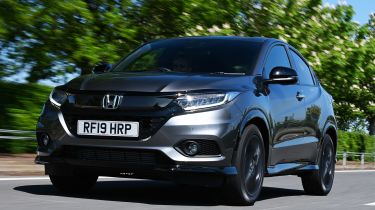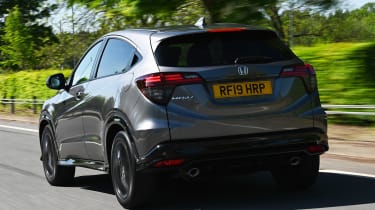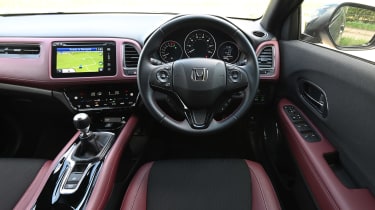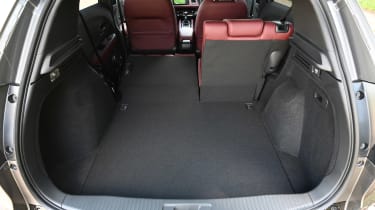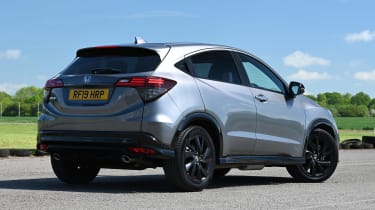Honda HR-V (2015-2021) review
The Honda HR-V is a reliable small crossover that offers decent space and excellent levels of safety

Every car maker worth its salt has a small crossover on its books these days, and Honda is no exception. The HR-V went on sale in 2016, and it slots into the range below the larger CR-V. It's based on the same platform as the Jazz supermini, but it has larger dimensions than most of its small crossover rivals, making it a practical choice in the class.
Rivals for the HR-V include cars such as the class-founding Nissan Juke, the Renault Captur, Peugeot 2008, Mazda CX-3, SEAT Arona, Citroen C3 Aircross, Vauxhall Crossland X, the Kia Stonic and Hyundai Kona. Prices range from just under £21,000 to around £28,000, making it a bit more expensive than some rivals, although you do get decent kit for the money.
As the HR-V is based on the same platform as the Jazz, there isn't scope for Honda to add four-wheel-drive, so all HR-Vs are front-wheel drive. Power comes from a 1.5 i-VTEC 130PS (128bhp) petrol engine, a 1.6 i-DTEC 120PS (118bhp) diesel or the most recently added 1.5 VTEC petrol with 182PS (180bhp) in the Sport model. All cars get a six-speed manual gearbox as standard, while the 1.5 petrols can be had with a CVT auto box as an option.
Used - available now
There are S, SE, EX and Sport trims, and all cars come with cruise control, climate control, flip-up back seats, a multifunction steering wheel, alloy wheels and a full set of safety kit, including automatic emergency braking. Further up the range, the HR-V features kit such as LED headlights, panoramic glass and Garmin sat-nav.
While the HR-V gets a decent kit list, it's not the most dramatic looking small crossover on sale - it's certainly outshone by the Toyota C-HR in that regard. However, if you want a versatile and spacious small family car that favours comfort over driving thrills, then the HR-V is worth checking out.
The HR-V name isn't new to Honda - it was used on an older high-riding model before the term crossover had been invented, and was arguably a precursor to the current trend for small models offering off-road looks and hatchback running costs.
The Honda HR-V is attractively designed without being overtly trendy, and it’s unusually spacious, too. It offers plenty of equipment and is well built and nice to sit in, whether you’re up front or in the roomy rear seats. There’s also a practical boot, which isn’t always the case in the style-focused mini-SUV sector.
It’s not the cheapest model in its sector, but the economical petrol and diesel engines keep running costs low, and Honda’s reputation for cast-iron reliability is reassuring. On the road, the HR-V performs well, and it’s more comfort- than sport-orientated – which will be welcome from a family car perspective. Buyers will also appreciate the ‘Magic Seats’ in the back, which have bases that can flip up cinema-style to give you more cargo carrying options.
Engines, performance and drive
Honda is only offering the HR-V with front-wheel drive in the UK, claiming that sales of small, four-wheel drive SUVs are tiny. The HR-V is based on the same platform as the Honda Jazz supermini, but is longer, wider and has a longer wheelbase than that car, so the HR-V's raised ride height doesn't have as big an impact on the cars handling as it otherwise might.
As for the driving experience, the HR-V performs pretty well and is a close match for the Nissan Qashqai in terms of comfort and handling. There’s plenty of grip, and less body roll than you get in the Nissan, even at higher speeds. Although the Honda’s steering is light and doesn’t deliver much feedback, it’s no worse than the Qashqai’s, and the car feels nimble when changing direction.
At low speeds, the HR-V has a decent ride and manages to smooth out bumps well, while at higher speeds it feels stable and secure, with only the biggest bumps sending shudders through the cabin. Wind and road noise are well suppressed, too.
Engines
Keeping things simple, there are just three engines available – a 128bhp 1.5 i-VTEC 130PS petrol, which is quiet and smooth, and a 1.6 i-DTEC 120PS diesel, which is also reasonably refined when compared to diesel engines found in rival cars. The recently added HR-V Sport brings a 180bhp version of the 1.5-litre petrol, along with reworked suspension and sporty styling touches.
Unless you do very few miles, the diesel is the best option. With just 118bhp, the i-DTEC isn't tremendously powerful, but it does have financial benefits, with a claimed maximum economy of 56.5mpg on the top-drawer EX model, and even better figures for lower spec cars with smaller wheels fitted.
Both engines come with a six-speed manual gearbox as standard, but the petrol engine is offered with an optional CVT auto. We're not fans of this kind of gearbox, and Honda doesn't offer it with any trick 'steps' in the gearchange like some rivals. That means it lets the engine rev harshly, and makes the petrol engine even less appealing.
The Sport model with its 180bhp is lively, with strong acceleration and lots of torque for easy overtaking. The manual gearbox option is best here, offering a snappy shift, while body control is improved over standard other HR-Vs thanks to some reworked dampers. The trade-off, however, is a fidgety ride that detracts somewhat from the HR-V's remit as a comfortable family car. We recommend sticking with the lower-spec cars.
MPG, CO2 and running costs
There are just three engines available in the HR-V: the 1.5 i-VTEC 130PS petrol, which is the same engine offered in the top-spec Jazz, the 1.5 i-VTEC 182PS in the Sport and a 1.6 i-DTEC 120PS diesel, which can also be found in the larger Civic hatchback.
When fitted with the six-speed manual gearbox, the 1.5 i-VTEC has claimed economy of 42.8mpg, depending on trim. Add the optional CVT gearbox and economy worsens slightly, with a return of 41.5mpg, or 39.2mpg in the higher-powered 180bhp version.
The diesel is only offered with the six-speed manual gearbox, and has a claimed figure of 56.5mpg in entry level S guise, while the SE and EX versions return 55.4mpg and 54.3mpg, respectively.
CO2 emissions for the petrol models are nothing to shout, emitting between 148g/km and 163g/km, although the diesel is better in this regard, with emissions of 132-135g/km.
Insurance
The Honda HR-V has insurance group ratings ranging from 19 to 27, which is pretty reasonable. Standard city braking and Honda's reputation for building cars with bulletproof reliability help with these ratings.
Depreciation
Buyers can expect the Honda HR-V to retain around 40-48% of its value over three years/36,000 miles, which is slightly better than some rivals in the small SUV class which struggle to break the 40% barrier. The lower-spec cars keep more of their original value compared to the more expensive EX and Sport versions.
Interior, design and technology
The HR-V may be based on the same platform as the Jazz supermini, but with a length of 4,335mm it’s longer than a Nissan Juke, despite competing in the same area of the market. It’s also larger on the inside than the Juke and matches up to the Nissan Qashqai, so the HR-V sits in the middle ground between Juke and Qashqai, the Renault Captur and Kadjar, and Mazda's CX-3 and CX-5.
In contrast to the Tonka toy-like styling of the Jeep Renegade and the cutesy curves of the Fiat 500X, the HR-V goes for more of a high-riding sporty look, just like the Mazda CX-3.
The HR-V exterior features a dark chrome front grille, rear chrome trim and a tailgate spoiler, while all cars include LED headlights and running lights. Moving up the range brings larger 17- and 18-inch alloys, along with front fog lights, with the EX equipment level adding a panoramic glass roof, roof rails and body-coloured trim. The Sport version deletes a lot of the chrome garnish, instead offering black-coloured trim and twin-exhaust pipes.
One surprise is that you sit quite low – one of the appealing things about crossovers is usually their high seating position – so the HR-V feels more like a conventional hatch from behind the wheel.
Sat-nav, stereo and infotainment
The HR-V's infotainment system is not the most up-to-date, with Apple CarPlay and Android Auto not even on the options list. The entry-level S-trim cars have a basic CD tuner, while SE versions and above feature a 7-inch touchscreen with sat-nav and a DAB radio, along with a six-speaker set-up (instead of four) and an extra USB port.
All HR-V variants also include a multi-function steering wheel and Bluetooth connectivity.
Practicality, comfort and boot space
The HR-V is based on the Jazz supermini, but it has been extended in every direction, not just in terms of height. It's longer than the Nissan Juke, and has the interior space to rival the likes of the larger Nissan Qashqai, rather than the Juke.
The HR-V’s trump card is its 'Magic Seats', which it shares with the Jazz. This system allows the rear seat bases to be folded up against the seat backs, meaning tall items can be carried inside the car, rather than left rolling around in the boot.
Size
The Honda HR-V measures 4,335mm long, 1,772mm wide and 1,605mm high, which puts it somewhere between supermini-sized crossovers and larger models like the Qashqai. Still, clever packaging, including a 2,610mm wheelbase, helps the HR-V deliver decent interior space. Ground clearance is between 178mm and 185mm, which gives away the fact that this is an SUV that's designed with on-road driving in mind.
Leg room, head room & passenger space
Despite its relatively compact dimensions, the Honda HR-V offers decent passenger space. There's plenty of room up front, although thick C-pillars mean over-the-shoulder visibility could be better, but the large rear window means the view directly out the back is good.
Rear passengers get a decent amount of room, and while the small rear windows make it feel a little claustrophobic, it's not as severe as you'll experience in the back of the Toyota C-HR.
Boot
The HR-V's boot measures up to 470 litres, although fold the rear seats down and there’s 1,533 to play with – that’s around 50 litres down on the Qashqai, but some 250 more than a Mazda CX-3 and nearly 350 more than the dinky Nissan Juke.
The HR-V's other party trick is its 'Magic' rear seats. These are borrowed from the Jazz supermini, and allow you to flip up the seat bases cinema-style to create a large flat load area between the boot and the front seats. It's a handy extra, and gives you additional cargo carrying options if you need them.
Reliability and Safety
Buying a Japanese car is considered by some a guarantee of reliability, so the Honda HR-V has a strong reputation to live up to. But while the Civic and CR-V are built in Swindon in the UK, the HR-V is produced in a factory in Mexico.
As Honda will have the same quality standards at all of its factories, this shouldn't be an issue. And besides, many of the HR-V's parts are shared with other Honda models, so you can be sure they have been tested extensively for durability.
The company placed 7th out of 30 car manufacturers in our 2020 Driver Power survey, if that helps to ease your mind.
The HR-V achieved a full five-star Euro NCAP rating in 2015. Entry-level S models come with Honda’s City Brake Active System as standard, while SE and EX models feature Honda’s Advanced Driver Assist System. This uses radar sensors and forward and rear-facing cameras to create a suite of safety systems. This includes Forward Collision Warning, Traffic Sign Recognition, Intelligent Speed Limiter, Lane Departure Warning and a high beam support system.
A tyre pressure warning, emergency brake assist, front side airbags, curtain airbags and two Isofix points in the back seats are also included in the list of safety kit.
Warranty
All Hondas come with a three-year warranty, which means any parts that fail due to manufacturing defects will be repaired or replaced free of charge. In addition, the exhaust gets 5 years of cover against corrosion, while surface corrosion is covered for 3 years, structural corrosion for 12 years and chassis corrosion for 10 years. Honda also offers an extended guarantee to buyers when the standard warranty expires.
Servicing
Service intervals are every year or 12,000 miles, whichever comes first. Honda offers a fixed-price service plan for all of its cars which covers them for up to five years. This can be transferred to a new owner if you come to sell the car before the service plan has expired.
For an alternative review of the latest Honda HR-V SUV visit our sister site carbuyer.co.uk
